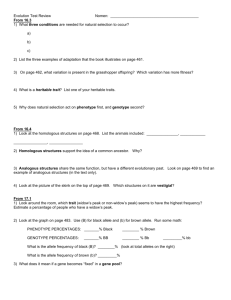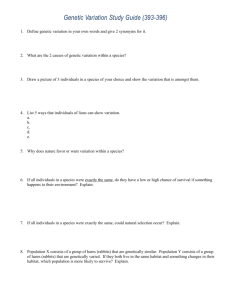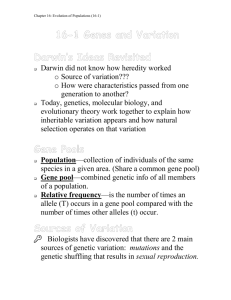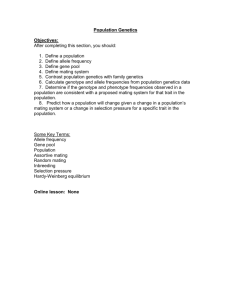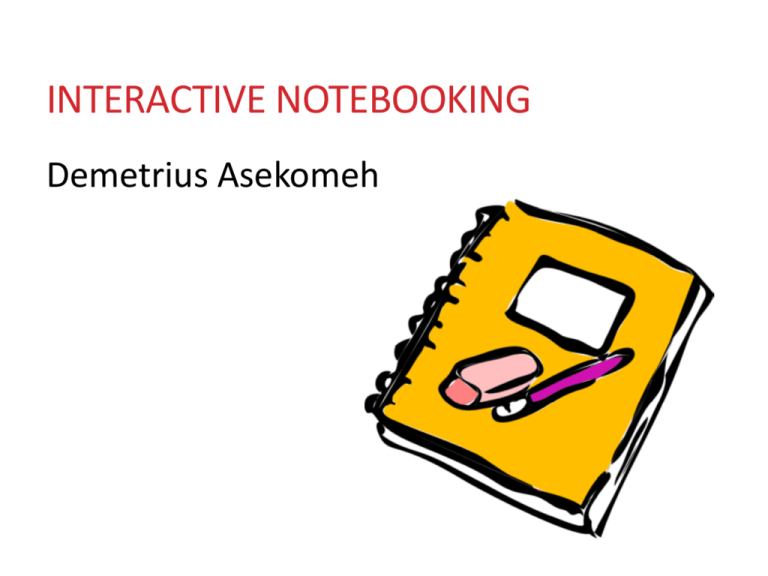
INTERACTIVE NOTEBOOKING
Demetrius Asekomeh
WEEK 1, PART 1
EVOLUTIONARY GENETICS OVERVIEW
IMSS BIOLOGY ~ SUMMER 2013
FRAMING THE WEEK
•
The integration of genetics with evolution
(evolutionary genetics)
•
How to help students make the connection
between evolution and genetics
•
How to approach student misconceptions
about evolution and genetics
•
How to accurately assess student
understanding of evolution and genetics
PROPOSED NGSS FOR CALIFORNIA
• Handout
• References
•
•
CA Department of
Educationhttp://www.cde.ca.gov/pd/ca/sc/ngssstandard
s.asp
NGSS Site http://www.nextgenscience.org/nextgeneration-science-standards
EVOLUTIONARY GENETICS
• Integration of molecular genetics with evolutionary
biology
• Evolution is descent with modification from a common
ancestor, i.e., change in inherited traits within a population
over successive generations.
• Genetics explains the process of trait inheritance.
https://www.coursera.org/course/geneticsevolution
CONCEPT MAPPING
• Tool of visual learning, type of graphic organizer
http://www.inspiration.com/visual-learning/concept-mapping
• Visual learning helps students see how
concepts/ideas are connected (especially to prior
knowledge) and organize large amounts of info
• Integrated with verbal strategies, aligned with
Common Core
• Good assessment tool
CONCEPT MAPPING – NUTS & BOLTS
1. Start with main idea/topic/issue or focus question
2. Identify key concepts that connect/relate to main
idea and rank them
• More general, inclusive concepts come first, then
link to smaller, more specific concepts
3. Finish by connecting concepts
• Establish links and cross-links, and create linking
phrases and words
CREATE AN EVOLUTIONARY GENETICS
CONCEPT MAP
• Create a concept map that includes the core
concepts/ideas that students need to understand
to connect genetics with evolution.
• Use the supplies provided (poster paper, sentence
strips, sharpies, colored yarn).
• You are welcome to modify/edit your map
throughout the week.
Sample concept map for photosynthesis & respiration.
QUICK WRITE REFLECTION
How do you make the connections between
evolution and genetics for your students?
Photo by Michael Skelton
HOW DO GENES DRIVE BIOLOGICAL DIVERSITY?
•
Evolution accounts for diversity over long periods of time.
•
Without genetic variation, mechanisms of evolutionary
change cannot operate.
•
Natural selection and genetic drift act on variation that
exists in populations.
•
Amount of genetic variation in a
population may affect the
likelihood of survival of the
population--less diversity, less
likely population will survive
environmental change
WHICH OF THE FOLLOWING DOES NOT CONTRIBUTE TO
GENETIC VARIATION IN POPULATIONS?
(A) Mutation
(B) Genetic recombination
(C) Gene flow
(D) Genetic drift
KEY PRINCIPLE: MECHANISMS OF EVOLUTION
• Populations have genetic variation that
continuously arises by chance events (mutation
and recombination) as well as gene flow.
• Populations evolve by changes in population allele
frequencies via
1.
2.
3.
4.
Genetic drift
Gene flow
Natural selection
Mutation
SELECTIVE PRESSURE FROM THE ENVIRONMENT
ACTS DIRECTLY ON
(A) the population gene pool
(B) phenotypes
(C) an individual’s genotype
(D) allele frequencies in a
species
This is because____________...
(Write answer in your notebook.)
SELECTION ACTS ON THE PHENOTYPE
•
Evolution occurs as result of selection pressures.
•
Biotic and abiotic factors within the environment put selection
pressure on the phenotype.
•
Phenotype is the physical expression of the genotype and the
environment.
•
Environmental factors acting on phenotypes result in certain
phenotypes with higher reproductive success (fitness) than others,
thus the corresponding genotypes ultimately change gene pool
changes.
allele
allele
HOW DO WE DEFINE PHENOTYPE?
•
Phenotype is the physical expression of a trait.
•
Such physical expression of traits depends on the
genotype and the organism’s interactions with the
environment.
•
How would you categorize phenotypic traits? What are
some examples?
Categories
Examples
FOCUS: THE INTERPLAY BETWEEN
GENOTYPE & PHENOTYPE
NATURAL SELECTION
•
Mechanism of evolutionary change that generates
biological adaptation.
•
Natural selection drives changes in the heritable
components of phenotype that are mediated by
differences in individual fitness
•
Phenotypes (thus genotypes) with the
greatest reproductive success (highest
fitness) are “favored” and become more
common in the population.
THE CONCEPT OF FITNESS
•
An individual’s fitness is the contribution that
individual makes to the gene pool of next
generation so depends on that individual’s
survival and reproduction.
•
The reproductive success of an individual
indicates its fitness but is often difficult to
measure, so proxies are more typically used, e.g.,
# matings, # offspring surviving to maturity.
NATURAL SELECTION ____ GENETIC VARIATION
IN POPULATIONS.
(A) reduces
(B) increases
(C) maintains
(D) can do all of the above to
This is because____________...
(Write answer in your notebook.)
NATURAL SELECTION CAN ACT ON POPULATION
VARIATION IN DIFFERENT WAYS
• Depending on the nature of the trait(s) being
selected, natural selection can increase, decrease,
or maintain the variation of the trait(s) in the
population.
•
There are different types of natural selection
•
•
•
•
•
Directional selection
Stabilizing selection
Disruptive selection
Balancing selection
Sexual selection
DIRECTIONAL SELECTION
•
Occurs when individuals with
one extreme value for a trait
are favored (or alternatively,
selected against), shifting the
average value of the trait in
one direction over many
generations.
•
This reduces genetic variation
for that trait in the population
DIRECTIONAL SELECTION – REAL WORLD
•
Numerous examples
•
Evolution of mimicry, camouflage, warning coloration,
etc.
•
The evolution of drug resistance in bacteria and other
microorganisms
•
Artificial selection
STABILIZING SELECTION
• Occurs when the extremes of
a trait are selected against.
•
This reduces genetic variation
for that trait in the
population
STABILIZING SELECTION – REAL WORLD
• Birth weight in humans – early mortality highest in babies
with extreme birth weights
• Too small – can’t keep warm, more susceptible to
infections
• Too large – more difficult to deliver through pelvis
• Clutch size in some birds – females that lay intermediate
numbers of eggs have highest reproductive success
• Too many – offspring
starve, more
predation
• Too few – not enough
survive to reproduce
DISRUPTIVE SELECTION
•
Occurs when selection favors the
extremes for a trait rather than
the central tendency, which is
selected against (i.e., individuals
with intermediate values of the
trait are eliminated).
•
This increases (or maintains)
genetic variation for that trait in
the population and can lead to
divergence into two populations
(and speciation).
DISRUPTIVE SELECTION – REAL WORLD
•
Documented in growing number of wild
populations
•
Most notably in populations experiencing intense
intraspecific competition for resources
•
E.g. Mexican spadefoot toad tadpoles
Omnivore morph (left) and
carnivore morph (right)
From
http://bio.unc.edu/people/faculty/pfenni
g/
BALANCING SELECTION
•
Involves a number of selective
processes that maintains the
presence of multiple alleles at a
particular gene locus in the
population’s gene pool, so
functions to conserve genetic
polymorphisms.
•
One of the major mechanisms of
maintaining polymorphisms is
heterozygote advantage.
HETEROZYGOTE ADVANTAGE – REAL WORLD
•
Found in recessive genetic diseases that have a
higher than predicted occurrence in a population
•
Heterozygote individuals (“carriers”) have higher
fitness than homozygotes.
•
Examples in humans
•
•
•
•
Cystic fibrosis
Sickle cell anemia
Thalassemia
Connexin 26 deafness
CYSTIC FIBROSIS
•
Caused by mutation in CFTR gene,
responsible for transport of ions (thus
water) into/out of cells.
•
Disease alters production of sweat,
digestive juices, and mucus which lead to
difficulty digesting food/pancreatic
obstruction, thickened lung
secretions/lung infections.
•
Highest prevalence in Ireland (1 in 19)
•
Heterozygotes don’t suffer from fluid loss
caused by the diarrhea associated with
typhoid and cholera.
SICKLE-CELL ANEMIA
•
Heterozygotes have greater resistance to
malarial infection and greater chance of
surviving to reproduce than either
homozygote—exposure to pathogen triggers
sickle cell reaction rapid removal of
infected cells.
SICKLE-CELL ANEMIA
•
Distribution of malaria and of sickle cell anemia overlap in
areas of Africa, southern Asia, and the Mediterranean. HbS
allele persists because heterozygous individuals are resistant
to malaria.
Credit: Encyclopædia Britannica, Inc.
B-THALASSEMIA
•
Carriers resistant to malaria and to coronary heart disease (due to
lower blood pressure)
http://www.hbpinfo.com/en/mainframe/id/beta.htm
CONNEXIN 26 DEAFNESS
•
Caused by mutation in GJB2 gene,
responsible for production of gap
junction protein (connexin 26) that
permits transport of ions between
adjacent cells (in e.g., inner ear, skin).
•
Up to 1/30 carriers in U.S.
•
Heterozygotes have thickened
epidermis and increased cell repair
capacity so increased barrier to
infection.
HETEROZYGOTE ADVANTAGE – REAL WORLD
•
•
•
•
Grove snail
Shows polymorphism in shell color controlled by multiple alleles—
individuals heterozygous for “super-gene” controlling these alleles
have physiological advantage over homozygotes.
Primary predator (Song Thrush) selectively captures snails that
stand out from background, but background is very heterogeneous
http://www.arkive.org/song-thrush/turdus-philomelos/video-00.html
www.telegraph.co.uk/
http://molluscs.at/gastropoda/terrestrial.html?/gastropoda/terrestrial/banded_snails.html
Figure 1 : Different types of selection
The red area denotes the current frequency distribution of a trait that is carried by individuals in a population. The
yellow area denotes the same distribution for a past generation. If there is enough time, the frequency will follow
changes in the fitness values associated with a particular trait value, so these figures also depict caricatures of
relevant parts of the adaptive landscape. The arrows indicate where the optimum is (or where it is moving) and
thus the trait values that will be positively selected. All other trait values are under negative selection.
© 2008 Nature Education All rights reserved. View Terms of Use
SEXUAL SELECTION
•
A special case of natural selection in which
selection acts traits that affect individual’s ability
to obtain mates.
•
Can lead to physical and behavioral differences
between sexes (sexual dimorphism); sometimes
the sexually selected traits are harmful to survival.
•
Mate chooses trait associated with “good genes”
that will be passed on to offspring.
SEXUAL SELECTION – REAL WORLD
•
Many examples, most commonly female choice
driving evolution of exaggerated male traits.
RESOURCES/REFERENCES
•
Understanding Evolution: one-stop resource for
information and resources on evolution from UC
Berkeley’s Museum of Paleontology
http://evolution.berkeley.edu/
•
Scitable by NatureEducation: a collaborative learning
space/library for science with emphasis on genetics and
cell biology (also containing resources related to ecology
and scientific communication)
http://www.nature.com/scitable

